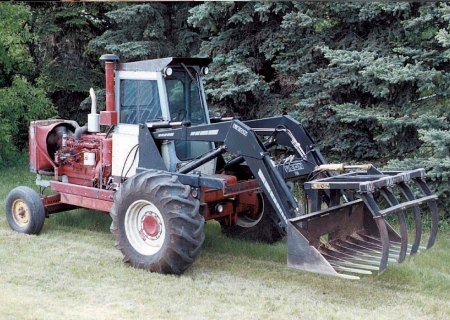
Spinning around the feedlot on a 2-WD tractor equipped with a front-end loader wasn't Lawrence Bespalko's idea of fun. His brother Edward didn't like it too much, either.
But an end loader or 4-WD tractor with a bucket was
well beyond what the Fort Qu'Appelle, Saskatchewan, brothers thought they could
spend. They upgraded to a real loader tractor by building their own from a couple
of old combines.
"Lawrence designed it and we built it
together," Ed says. "We put up hay with a Hesston stacker and feed
hay with the front-end loader. We also use it for scraping and loading manure,
so we spend a lot of time on the loader."
They started with an IH 815 combine and stripped it
down to the frame. "All we had left was a big wheel assembly and the two
channel irons attached to that," Ed says. They used the original engine
and hydrostatic transmission from the 815, but remounted the engine farther
back for better ballast.
To ensure they had plenty of strength in the machine,
they added an extra frame from a late 1950's or early 1960's Case 1000 combine.
Wheels, axles, and power steering all came from the 815.
With the engine in place, they designed and installed
framing and bracing for a quick-attach Leon's front-end loader.
They use a 6-ft. wide self-leveling bucket with a
grapple fork on it, so they can use it for hauling both manure and feed.
They designed and built the cab to look more like the
cab on a big backhoe and mounted it near the center of the frame. "It has
a sloping top, with a window in the front, so we can see the bucket when it's
fully raised," Ed says.
While the engine is usually heavy enough to counter the
load on their bucket, they clamped 600 to 700 lbs. of flat steel to the back of
the frame. This weight is removable, though they've never taken it off. They used the original combine tires on the drive
wheels.
The Bespalko brothers built their loader 7 years ago,
mostly to save money. The original 345 cu. in. 8-cyl. gas engine has since been
replaced with an IH 414 cu. in. diesel engine. "We could have bought a
used bi-directional tractor or something similar. But the total cost of our
conversion was much less."
They're still not quite finished with the machine. An
engine hood and a mast for a fork lift are in the design process.
"It took a lot of time and labor to make this
conversion, but in the long run it saved us a lot of money."
